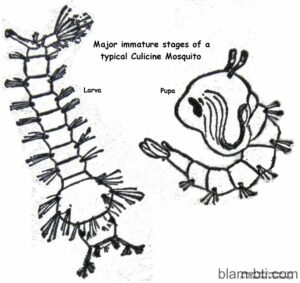Can I use water treated with BLAM to water my plants, vegetables and fruits?
Yes: BLAM is perfectly suited for this and presents no danger for plans.
For your vegetables a simple rinsing is enough before eating.
Why is the dosage expressed in m² and not in volume (m3)?
Mosquito larvae live essentially at the water surface to breathe. Therefore, only surface should be taken into account. A pond of a certain surface should be treated in the same manner no matter its depth.
Can I use BLAM in water trays below my plants?
Absolutely: this is even recommended! As explained in the section “How to use BLAM” the ideal application method is first to dilute the powder in a container and then pour this mix in your water tray.
Is BLAM toxic for my pet (dog / cat…)
As long as you respect the application dosage the water will not be toxic for pets. BTI (Bacillus Thuringiensis Israelensis) the active substance of BLAM BTI has no adverse effects on mammals, fish, birds, plants and most insects with the exception of its target pests: mosquito larvae, fungus gnat larvae, black fly larvae.
Why are there still mosquito larvae after I applied BLAM?
3 potential reasons:
- BLAM takes 24 / 48 hours to apply. Did you wait long enough? And did you respect the dosage?
- After application of BLAM new mosquitos will continue to lay eggs in the water. For about 14 days BLAM will kill these new larvae: your water becomes a mosquito trap! After you need to renew the application of BLAM.
- BLAM only affects larvae: from the moment larvae become nymphs BLAM is no longer efficient.

Are insects becoming resistant to BTI?
No. There is no documented resistance to BTI as a larvicide. A recent study confirmed previous research showing a lack of BTI resistance in mosquito populations that had been treated for decades with BTI.
BTI is not a pesticide: it is a natural bacillum that must be eaten by the larvae.
Does BTI pose risk to crops or water supplies?
No. BTI has no toxicity to people, so it can be applied safely to mosquito habitat without a detrimental impact on food crops or water supplies. In fact, BTI can be used for pest control in organic farming operations.
Is BTI harmful to wildlife including honey bees?
Studies indicate BTI has minimal toxicity to honey bees. BTI produces toxins that specifically affect the larvae of only mosquitoes, black flies and fungus gnats. These toxins do not affect other types of insects including honey bees.